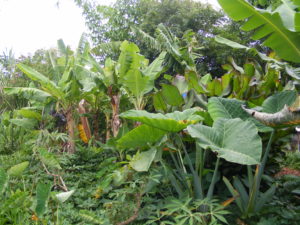
Perennial ecological staple food mix
With this foundation of perennial crops you can create a resilient and fail safe range of gourmet, nutritious foods that will provide you with most of your staple food needs throughout the year, with very little ongoing effort.
Let’s have a look at some of the perennial range available to us now…
Tubers and starch crops (All of these are very hardy but prefer frost free locations to remain perennial. They have the advantage that their yield does not require to be harvested all at once, but can be taken fresh as required over extended periods). (Cassava; Sweet potato; Taro; Coco Yam/Tannia; Yacon/Earth apple; Arrowroot; Sunroot/Jerusalem artichoke; Climbing yams (Dioscoria sp.); Choko; Chilacayote/Perennial squash; Peruvian parsnip.
Leafy greens, stems and shoots ( Most of these are extremely prolific during the warm part of the year, a few prefer the cooler months and all create copious quantities of nutrient packed foods that can be used in a variety of ways).
( Abika/Tree spinach; Katuk/Star gooseberry; Cranberry Hibiscus; Warrigal greens; Mushroom plant; Okinawa spinach; Surinam spinach; Tahitian spinach; Ceylon spinach; Kale and Collards; Kangkong/water spinach; Rhubarb; Asparagus; Globe Artichoke)
Herbs and spices (A rich mix of concentrated vitamins and flavours. These species also make great permanent habitat for many beneficial organisms in the organic garden ecology).
Perennial basils; Lemon and citronella grass; Ginger; Galangalal; Turmeric; Cardamom; Horse radish; Shallots, Garlic, leeks and chives; Aloe vera; Lemon verbena; Lemon and lime balm; Comfrey; Mint varieties; Nasturtiums; Five spice herb; Curry tree; Bay leaf tree; Cinnamon tree; Pepper vine; Vanilla orchid; Oregano, Rosemary, Thyme, parsley, dill, fennel
Legumes ( Ranging from trees and shrubs to ground covers and vines, all produce protein rich foods for humans and animals and most of these also fix nitrogen and improve soil fertility.)
Carob bean; Ice cream bean; Leuceana; Pigeon pea; Honey Locust; Tamarind; Jicama/yam bean; Pea nuts; Lablab/hyacinth bean.
Nuts (Great storable concentrated foods for humans and animals, and plants that are very hardy and can be utilized as windbreaks and privacy screens)
Saba nut/Malabar chestnut; Bunya nut; Macadamia; Pecan; Chestnut; Peanut tree; Candle nut; Bopple nut; Atherton almond; dwarf Coco nut; Cashew nut;
Fruits that can yield all year (This range of fruiting species will produce for most of the year once established into their optimal microclimatic niches)
Avocado varieties; Pepino; Tamarillo; Papaya and pawpaw varieties; Babaco and Mountain pawpaw; Banana varieties; Pine apples;
Berries ( With this range you will have fresh delicious berries throughout the year and ranging from ground covers, bushes and shrubs, an entire berry forest can be created).
European Rasberries; Thornless Blackberries; Boysen berry, young berry, logan berry; Blue berry varieties; Strawberry varieties; Gogi berries; Midyim berries; Elder berry; Atherton Raspberry & Panama berry, ( both Winter fruiting); Mulberry varieties including the white and red shartoot; The indigenous roseleaf raspberry, Molucca bramble, apple dumpling berry and others.
Aquatic garden ( Make any dam, pond, creek or permanent damp area, a productive hot spot with these water loving crops)
Taro; Kangkong/water spinach; Rice; Water chestnuts; Sagittaria waternut; Lebanese and water cress; water mint; Water celery; Lotus; Nardoo; Papyrus; Cumbungi; water ribbon; water lilies; Mulberry; Figs;
All of these perennial crops can be grown successfully in the Sub-tropical climate of the northern rivers and together offer a great opportunity for residents to achieve home grown gourmet food security regardless of seasonal variations or extreme events.
Many of these species may be currently unfamiliar as part of the typical Australian diet, although in many other countries, the same crops are considered to be staples and cherished for their unique properties and the foods prepared from them. Just as Australians have adopted many new dishes and cuisines from other cultures, so too we can learn directly from the cultures that have strong traditional knowledge of how to use these perennial crops directly, many of these are already living here among us.
In an even wider context, this perennial range can be planted out in a strategically designed way to also accommodate the additional vast range of seasonal fruiting trees and shrubs and to also incorporate places where our traditional annual crops can also be grown efficiently.
The more we can design and create human habitat in symbiosis with nature’s inherent processes, the work of food production can be handed over to the power of nature to achieve yields effortlessly. We can then have more time available for other activities and be enthralled with the endless diverse harvests of fresh seasonal gourmet foods directly from our own organic gardens and farms.
Recent Comments